
This account of ascents in the Alps covers all of the route information I was supplied or could find that involved Brits. It also covers my personal and close relationship to some of these routes, a bit of history, a look at style, ethics and reporting. The account is by no way definitive and I apologise for the ascents that took place in 2007 that I missed. If you know of any please add them to the forum thread associated with this article. What I have also done is to make an attempt to include people who rarely get a mention.
The report was written in November 2007. I have been living in Chamonix since and I know much has been climbed since I wrote the report.
I hope it provides you with inspiration.
Nick Bullock, Chamonix.
Heaving the rucksack from the snow, I throw it over the mouth of the crevasse and stand in awe of the small man who catches it on the opposite side. My torch beam swings from the dark of the hole, lighting snow-crystals, and into his face... and into his eyes. Features, angular like a piece of furniture beneath a sandy, short crop of hair. Determination radiates, mixing with the clouds of condensation he breathes. This was my first time climbing in the Mont Blanc Range and here I was throwing Valeri Babanov his pack beneath the austere north face of the Grandes Jorasses. Babanov hoped to solo the Colton-MacIntyre. Owain Jones and I hoped to climb the Croz Spur, but on this occasion neither teams were successful.
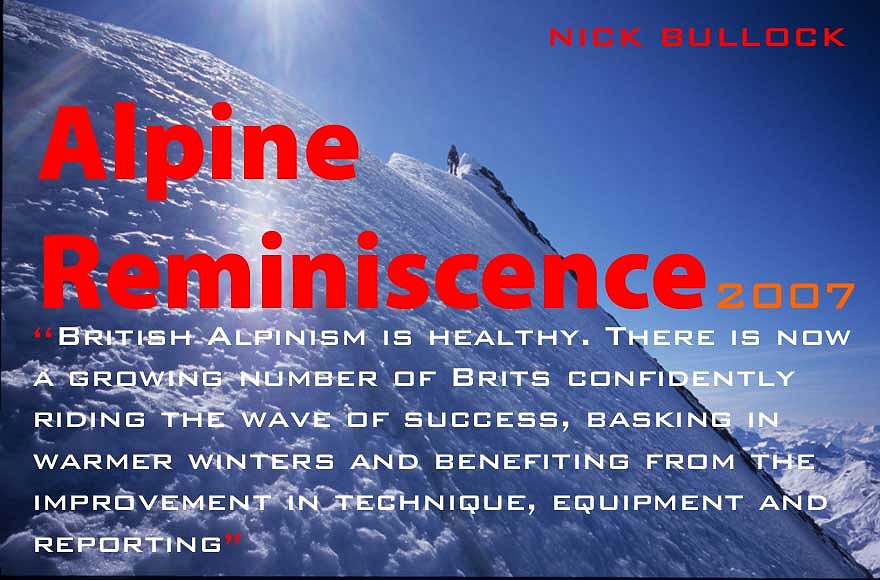
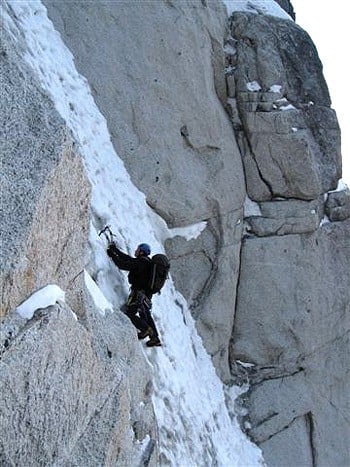
Perspectives change with time and progression. Boundaries are pushed. Climbs that were once held in awe, become, in the right conditions, de rigueur. Don't be tricked, these climbs, faces and mountains are serious; dues have been paid.
British Alpinism is healthy. There is now a growing number of Brits confidently riding the wave of success, basking in warmer winters and benefiting from the improvement in technique, equipment, and reporting.
December 2006 and early 2007 gave superb conditions on several of the faces accessed from the Valley Blanche. An unsettled period in late February and early March slowed things for a while until Toby Keep and visiting American Kevin Mahoney climbed the Dru Couloir, (Cecchinel-Jager VI 5, 5c, A1, 28th-31st Dec 73). Keep, a determined ex-fireman says,
“The climbing felt tricky even though the route was in great condition. Kev went off route, it got dark and I was scared. Occasional shouts of "Watch me here" and "Forfucksakeman" plummeted to my position, but mostly he was awesome, he led all the tricky bits.”
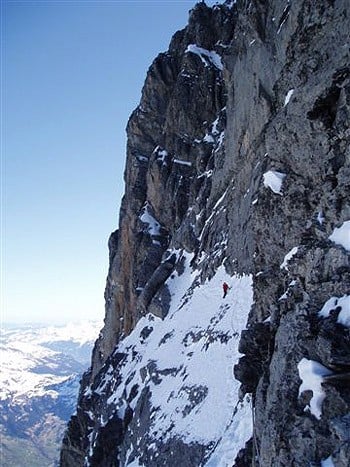
Three weeks later after climbing the Cosmiques Ice Fall with Miles Bright and the Modica-Noury with James Edwards, Keep, together with Rick Marchant climbed the Eiger 1938 Route with one bivvy at Death Bivouac. Keep recalls,
“On the train, passing beneath the 1,600-metre North face, I felt very apprehensive not knowing Rick at all, but it must have been even more daunting for him, he is a qualified mountain guide and has loads of experience...I'm not.”
The pair topped-out at 5pm on the second day. After brewing-up they descended the west flank racing beneath the seracs and reaching the train tunnel in 2-hours. A French party who topped-out behind Keep and Marchant took the rocky descent. In the dark, down climbing, one of the French team fell and was killed.
Still not content, (or was it he really wanted to make sure of that guides application acceptance) Keep rounded off his winter with an ascent of the Lagarde Couloir on the Droites, (IV 3, Arsandaux-Lagarde, 1000m, 1930) with James Thacker descending via the NE Slope of the Courts; The Supercouloir to the summit of the Tacul with the Gervasutti Pillar Start and finally, the Brown-Patey (Joe Brown, Tom Patey, V 5, 6a, August 1963) into the Marsigny-Mohr (François Marsigny-Philippe Mohr, IV 4, January 1990) on the Aig Sans Nom, with James Thacker and Dave Hollinger.
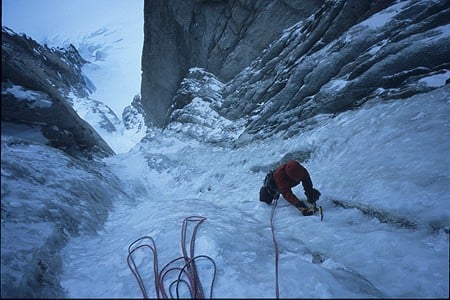
Tony Penning, Ali Taylor, Nick Gillet and Gavin Cytlau travelled to the less frequented Italian side of the Mont Blanc Range, a place Penning knows well having climbed there many times. The visit resulted in four new routes. The longest and most serious being La Fiesta de los Monstors on the East Face of the Aiguilles de Pre Sec, an eleven pitch E3 5c with a difficult approach taking 8-hours with one bivvy. Checkmate, a 10 pitch 500m, E3 5c, was Pennings sixth route on the Aiguille de l' Eveque above the Frebouze Glacier, followed by Franci and Vale, a five pitch HVS on the untouched west faces of the Petites Aiguilles de Pra Sec. Finally, with the team of four on one rope, Sexy Beast, a 5 pitch E3 5c on the Eveque Slabs was climbed. Loose rock, a steep hand traverse and tufts of grass barely strong enough to take weight made this the most adventurous of the four new routes.
In late July and early August fatalities from hypothermia, stumbles, falls from paths, falls from climbs, through cornices and into crevasses reached record proportions. I do not climb in the Alps in summer and the body count of approximately thirty in one month (the second highest figure in history over such a short period) confirms why I believe this to be the correct decision.
“It's shaping up to be a really good autumn and winter,” friend's in Chamonix told me, but after spending six weeks on and around a big snowy hill in India, I chose to ignore their claims. What a mistake.
Early September started well with Rich Cross and Dave Horwood climbing the Escarra Route (NW Couloir) on North Face of the Chardonnet, (III 4, Jean Escarra, Étienne Payot, Émile Borgeat, 400m, 1929) quickly followed by an attempt at Fil D'Ariane in Cirque Mordet, stopping 2-pitches from the top as the heat was making the climb dangerous.
Owen Samuels and James Smith climbed the Frendo Spur on the Aguille de Midi North Face (Frendo, Rionda, D+, July 1941, 1100m). Conditions on the rock section were reported as icy, but superb snow on the arête and the left hand finish made up for time lost. Mat Perrier, the once Llanberis based boulderer, know affectionately as UG, also climbed the Frendo Spur as his first Alpine route in the same week as he climbed his first 8a. 
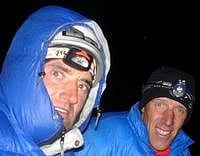
“Tough pitches up less than perfect rock, a point of aid, dry tooling, rock climbing, a bivvy without sleeping bags and a pants-filling rotten rock detour, that Brodie eventually circumnavigated with a protection-less display of fine climbing back on the original line”, before topping out on day two, suggests an adventure well worth reporting that will inform and inspire.
At a similar time to the ascent of the Bonatti-Voucher, Rich Cross and Dave Horwood climbed the Petites MacIntyre (MacIntyre, Rhodes, Todd, IV 4+, 600m) on the North Face of the Grandes Jorasses. A more significant ascent on the Grandes Jorasses North Face was one by Guy Robertson and Pete Benson of the 38-pitch, Gousseault Route, (Desmaison, Bertone, Claret, VI 6a A1/A2, 1200m 1971). The pair, both from Scotland made a free ascent (VI 6b/c, M5-M7 13th-16th October) over four days. Possibly more interesting than the climb itself, of which Robertson said, “Was positively orgasmic, never have I done anything with so much sustained, varied and high quality climbing from glacier to summit in my life”, was the approach.
The Montenvers Railway was shut so after taking advice from a local ex-pat mountain guide - who shall remain nameless as I may want to doss in his house - a seven-and-a-half-hour walk down the Valley Blanche from the top station of the Midi Telepherique was decided the best approach. A sprint beneath the carving seracs of the Geant icefall and a quick waist deep plunge into a glacial pool made them wonder if this was the best approach.
After drying out in the Leschaux Hut, they eventually reached the foot of the climb the following morning. The first free ascent, with a new direct start, of the Gousseault was made by Tobin Sorenson and Gordon Smith in October 1977. “The right hand is definitely the most logical start to the route,” says Smith.
Sorenson, an American and Smith, a Scot, had two nights on the climb, the second of which was surviving a blizzard while wrapped in a tent. The morning of the third day brought driving snow and gales with gripping climbing ... “Tobin led the crux headwall pitch with two falls and much wailing about the need for a sky hook, he was brilliant," recalls Smith, “All of his gear was borrowed and this was only his second ice route.”
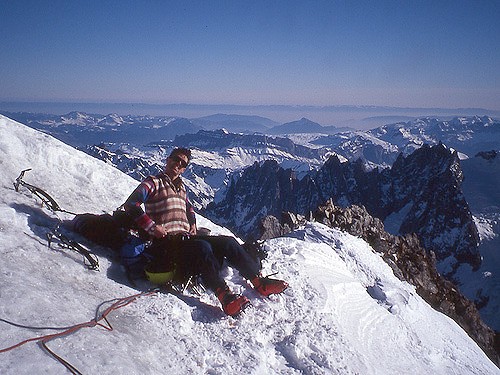

The Colton-MacIntyre (Nick Colton, Alex MacIntyre,VI 6, 1200m, 1976) has seen numerous ascents through September and October. I think this is a clear example of standards rising with the onset of better equipment. More important is the speed of reporting the conditions, the improved weather forecasts, the reduction in the cost of flying and the ease of getting to Chamonix. In the winter of 1972 the Colton-MacIntyre was attempted by Bonnington, Burke, Clarke and Haston. A plane flew the team and a deposit of equipment onto the Leschaux glacier, where, after 17 bivouacs and with fixed ropes, they only managed to get to 350m below the ridge. Attitudes have definitely changed along with understanding of what is possible.
Andy Houseman and Ross Hewitt, just one of the many teams who climbed the Colton-MacIntyre reported Styrofoam ice for nearly the whole length of the climb. Houseman's take on the route is “A pretty good climb with a couple of spicy pitches.”

Ian Parnell and Kenton Cool, teaming up for the first time since guiding Fiennes on the Eiger, climbed what is possibly the first British ascent of a line first climbed by Gerald Durand and Philip Batoux on February 19th 2007. The Durand-Batoux (III, WI5+, M7, 500m) is on the rock triangle below the Courturier Couloir on the north face of Aiguille Verte.
“The crux felt more like VI/7 with a surprising amount of gear beneath the thin ice, all easier than expected, but well worth it”.
The day turned, “Kind of typical,” for a Cool and Parnell outing with Kenton barfing on lead due to being stuffed full of pills to reduce the pain of a toothache.
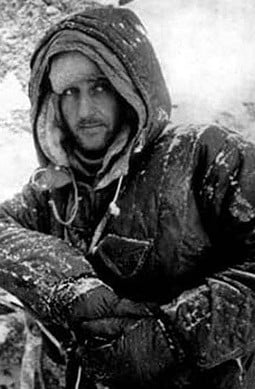
“And anyway, Marc would have beaten me up if I had started poncing around trying to free-climb into the groove.”
“Brits get way too anxious about 'free-climbing' every move on a big Alpine mixed face. As far as I'm concerned 'free-climbing', (and I use the term loosely because pulling off a big handle attached to a metal spike, stuck in a crack, is over-stretching the boundaries of 'free' by quite a margin) is great as long as it doesn't upset the rhythm of the ascent.”

In the past nothing would have been said about this, no-one would have known or cared. I see Brodie's point about the desire for immediate reporting on the net being too instant and too easy. Have we all lost something by being too well informed?
Brodie finishes by quoting Andy Warhol,
“If you look at a thing for long enough, it loses all its meaning", and finishes by asking me
“When are you going to get out into the mountains rather that just banging away about it all day in front of a computer”?
Thank you to Kevin Mahoney,Toby Keep, Ross Hewitt, Rick Marchant, Marek Piekarski, Pete Benson, Kenton Cool, Marek and Jon Bracey for the photographs illustrating this report.
Also read Nick Bullocks report, Chamonix Alpine Report published March 2007 at UKClimbing.com, here
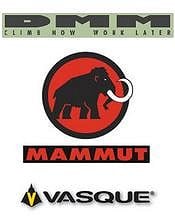
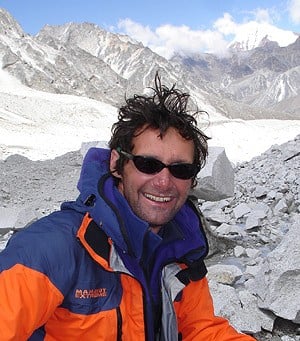
In Wales he made the first ascents of Cracking Up IX/9 and Travesty VIII/8 on Clogwyn Ddu. Snowdonia. On Ben Nevis he made the first ascent of Avenging Angel, VII/8 and in the Lakes he made the second ascent and first onsight of Snicker Snack on Great Gable (VIII/9).
He has made many fine ascents in the Huayhuash range and the Cordillera Blanca iof Peru, has attempted Shark's Fin and Changabang in India and climbed extensively in Pakistan and Nepal.
Nick is also a writer and you can read some of his work at UKClimbing.com. His essay Echoes, recalling his 15 years working in the Prison Service provoked many responses down the forums and has been read over 4,000 times. Read Echoes (click here)










Comments